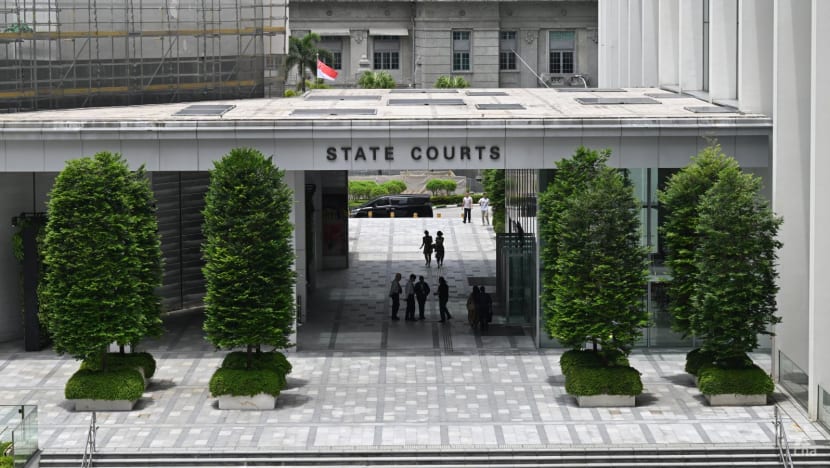Technician suffocated to death in underground gas chamber meant to stun pigs before slaughter: Coroner
The man reportedly said he had gone into the chamber before without issue and entered wearing only an N95 mask for protection.

The State Courts of Singapore (File photo: CNA/Jeremy Long)

This audio is generated by an AI tool.
SINGAPORE: A 44-year-old Malaysian died by suffocation in an oxygen-deprived underground chamber that was part of machinery meant to stun animals before slaughter in a pig abattoir.
Mr Hoe Chee Meng was a maintenance technician who lived in Johor Bahru and commuted to Singapore daily for work as a maintenance technician at pig abattoir and local pork distributor Primary Industries.
In findings released over the weekend, a coroner found that the death was a work-related accident which could have unfortunately been prevented if Mr Hoe had followed the protocol for entering and working in a confined space.
WHAT HAPPENED
On Jul 18 last year, the carbon dioxide stunner, which was part of the machinery located at the company's abattoir block, broke down.
The machine included a "ferris wheel" system where pigs in metal cages, known as gondolas, were lowered into an underground chamber filled with carbon dioxide.
The chamber was about 2.3m by 3m, and was around 3.8m deep. The top of the chamber was not fully enclosed, to allow gondolas to revolve in and out.
A gas detector behind the operator's work area monitored the ambient carbon dioxide level within the chamber, and the carbon dioxide supply to the chamber was controlled by a hand valve, the coroner's findings stated.
The underground chamber was accessible through a manhole in front of the machinery, where there was a sign warning about the confined space in the chamber.
The manhole cover was secured with two bolts, and there was a safety interlock switch on the underside of the manhole cover to ensure the machinery would not operate when the cover was open.
However, at the time of the accident, the safety interlock switch had reportedly been damaged, with the replacement in the midst of being connected and tested.
A person could gain access into the manhole using a fixed vertical ladder with a safety cage installed at the manhole opening.
According to investigations, the machinery lost power and broke down on the morning of Jul 18, 2023. The maintenance team began troubleshooting soon after, working until 5pm, when their shift ended.
The next morning, four other maintenance technicians continued the work and at about 11.30am, the team opened the manhole cover, suspecting that the machinery fault could be traced to faulty electrical wiring of the manhole cover safety interlock switch.
While one of the workers, Mr Kathiravan Narajan, was dismantling a bracket that secured the machinery door bearing, the bracket slipped and fell into the underground chamber.
Mr Kathiravan said he would enter the chamber to retrieve the dropped bracket but was told not to do so.
He decided to go in anyway and put on a surgical mask, along with a respirator that covered half the face - not a suitable protective equipment for entry into oxygen-deficient confined spaces.
However, Mr Kathiravan felt overwhelmed just 32 seconds in and was helped out by his colleagues.
When the assistant manager of maintenance Mr Martin Ng Soo Leong heard about this incident, he chided Mr Kathiravan for going into the chamber unsafely and told the team to fabricate a replacement bracket instead of trying to retrieve the fallen one.
However, the workers could not find a spare bracket and thought about asking Mr Hoe because he was experienced in machine maintenance.
MR HOE CALLED IN
Mr Kathiravan contacted Mr Hoe, who was stationed at another location and had not been involved in troubleshooting.
Mr Hoe knew that there was no spare bracket lying around. Instead, he went to the machine, wanting to enter the manhole to retrieve the bracket.
At about 3.10pm, Mr Hoe obtained an N95 mask from the maintenance workshop and informed Mr Ng that he was going to enter the chamber to retrieve the dropped bracket.
Mr Ng later stated that Mr Hoe had claimed that he wanted to go into the manhole to retrieve the bracket, and that he had done it many times before without issue.
Mr Ng also said he asked Mr Hoe: "What if you die inside?"
He said Mr Hoe replied: "Die then die lor."
Mr Ng said he did not know if Mr Hoe was joking but recalled that the company's management had told him to use a more gentle approach when dealing with workers, so he "unknowingly" followed Mr Hoe to the manhole.
Mr Hoe put on the mask and entered the chamber. He began shivering. About 30 seconds after entering, he tried to climb back up the ladder to exit, but collapsed and fell back into the chamber, losing consciousness.
Mr Ng instructed the other workers to call for help and to douse Mr Hoe with water in an attempt to wake him.
He also got workers to set up air blowers to supply ambient air into the chamber.
The Singapore Civil Defence Force arrived at the scene shortly and extricated Mr Hoe. He was taken unconscious and pulseless to Ng Teng Fong General Hospital and pronounced dead that same day.
The cause of death was consistent with suffocation in an oxygen-deprived environment and was not the result of a natural disease process.
The court heard that it was highly likely that the oxygen level in the manhole was severely reduced when Mr Hoe entered it, so he lost consciousness, collapsed and died.
Mr Hoe had three children with his wife, named only as Madam How, and the family lived in Johor Bahru.
Mdm How said her husband had started working for the company in 2015 and seldom discussed work matters with her.
She raised concerns in the inquiry, asking what her husband was doing inside the manhole when his job scope clearly did not require him to do so.
INVESTIGATIONS
Investigations by the Manpower Ministry found that Mr Hoe had not been working excessive hours and that it was unlikely that work fatigue contributed to the accident.
A re-enactment of the accident scene by MOM to simulate gas measurement resulted in a gas sample at the bottom of the chamber that showed the lowest concentration of oxygen, confirming that residual carbon dioxide had settled near the bottom of the chamber as it was heavier than atmospheric air.
The oxygen level at the bottom of the chamber near Mr Hoe's breathing zone was 13.5 per cent, which was not within the safe range of 19.5 to 23.5 per cent oxygen as stipulated in the Workplace Safety and Health (WSH) (Confined Spaces) Regulations.
According to the WSH Council's technical advisory on working safely in confined spaces, a person exposed to an environment with oxygen concentration between 12 per cent and 14 per cent would experience rapid pulse and difficulty in breathing.
Tests were made for harmful gases including carbon monoxide, hydrogen sulphide and methane but none of these were detected in the chamber.
After the accident, MOM conducted an inspection at the company and issued a stop-work order after observing non-compliance.
The order was lifted in October 2023 after the company put into place control measures to prevent the recurrence of such an accident.
These include establishing an effective confined space programme, establishing lock-out procedures and a key control system to control access to confined spaces, retraining workers on the hazards of entering confined spaces and reviewing risk assessment and safe work procedures for repair and maintenance work.
At the time of the coroner's inquiry, MOM was contemplating taking enforcement action against the parties involved.
In her findings, Coroner Wong Li Tein found that the workers were aware that they should not enter the manhole, which was a defined confined space.
This was partly because safety measures had to be deployed to enter it and also because the company had engaged external contractors to do work involving confined spaces since 2019.
The coroner found that Mr Hoe was trained in work conducted in confined spaces and knew what control measures had to be deployed before any entry.
This was not the first time he had attempted to rectify works in a confined space.
"Prior to entering the manhole, he was asked by his colleagues not to do so and was even warned that Mr Kathiravan tried to do so earlier and was overwhelmed by the gas in the chamber," said Coroner Wong.
She found no foul play involved in the death and conveyed her condolences to Mr Hoe's family for their loss.














